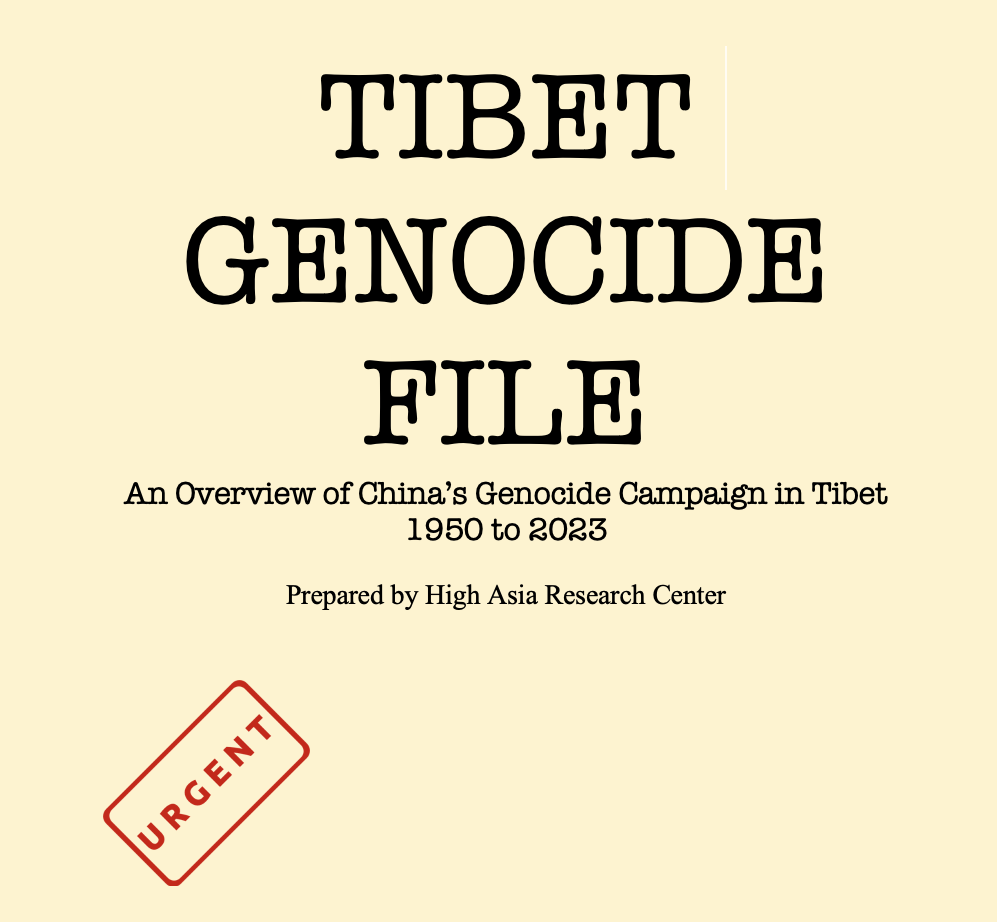A Preliminary Overview of China’s Genocide Campaign in Tibet: 1950 to 2023
HIGH ASIA RESEARCH CENTER
INTRODUCTION
The International Commission of Jurists in Geneva (ICJ), in their report on Tibet of June 24, 1959, stated that there was prima facie evidence that Communist China had “…committed acts of genocide in Tibet, with the intention of destroying the Tibetan nation and the Buddhist religion in Tibet.”[i]
Genocide in Tibet has a long history, one that has evolved over the decades, often in line with changes in China’s own politics. Yet it has never deviated from its ultimate goal of eradicating Tibetans as a people and a nation. Right now, in 2023, China is carrying out a systematic but low-profile genocide program across Tibet through its Colonial Boarding School Program.
This survey is not a formal study but aims to provide a general overview of the Tibetan genocide, aspects of which have been reported by international agencies often as cases of human rights abuses but have not been viewed as integral constituents of the overall genocide campaign being carried out in Tibet. High Asia welcomes your comments, guidance, and support for this ongoing project.
THE GREAT TIBET FAMINE 1959 — 1979
Following the March ‘59 Uprising, and the escape of the Dalai Lama, the Chinese occupation authorities imposed punitive measures on the Tibetan population, confiscating food grain from individual farmers and emptying district, monastic, and central government granaries all over Tibet, where, according to the Dalai Lama “food supplies had been sufficient for centuries.”[2] By the end of 1959 young children and the old began to die. In the following years full-scale famine hit the Tibetan population.
Some see this tragedy as part of the Great Chinese Famine (1959-1962) which killed upwards of 55 million people. But unlike China, no communes had been established in pre-59 Tibet and it had not experienced drought or crop failures. The first major book on China’s famine noted that “…no other group in China suffered more bitterly from the famine than the Tibetans, of whom perhaps one in five died during these years. In the birthplace of the current Dalai Lama in Qinghai province, at lease 50 per cent of the population starved to death.”[3]
Tibet’s famine resulted largely from the confiscation of food grain, which was used (in part) to pay China’s debt to the USSR following the 1956 Sino-Soviet split.[4] “Even in places as far away as Gansu (Amdo), villagers protested that they had to go hungry because Mao was shipping grain to Cuba.”[5] The 10th Panchen Lama in a secret report to Chou Enlai described the uniqueness of the famine that Tibet suffered: “There was never such an event in the history of Tibet.” He added that the famine was “the result of official policies, not of any natural disaster.”[6]
The famine in Tibet could be compared to Ukraine’s Holodomor or ‘Terror- Famine’ of 1932-34, in which millions of Ukrainians died in Stalin’s genocidal retribution for their independence movement. A unique aspect of the Tibet famine was its duration, which according to China expert Jasper Becker “… was endemic for twenty years.”[7]
FORCED-LABOR (LAOGAI) CAMPS
Since the launch of Mao’s “Democratic Reforms” in Eastern Tibet in 1954, Beijing commenced large scale implementation of its Laogai or “Reform Through Labor” penal system involving the use of forced labor, prison farms camps, and prison-mining camps throughout Tibet.
Following the Lhasa Uprising many thousands of Tibetan prisoners were forced to work at the the Nachendra hydroelectric project northeast of Lhasa. The old prime-minister Lobsang Tashi was also incarcerated at this labor-camp and served five years there.[8] Another major Laogai project was the Guoduo hydroelectric power plant, located on the upper reaches of the Mekong River in Tserwé Township, which served Chamdo and surrounding areas and was built exclusively with prisoner labor. These two and similar laogai projects can be compared to Stalin’s White Sea Baltic Canal, especially in the high death rate of the labor force.
Prison farm laogai camps were widespread throughout Tibet but the camps at Powo-tramo and Kongpo (Lingchi) are notable as they were created by forced-labor from forests and virgin land in these districts. These were intended as settlement colonies for retired PLA soldiers and Chinese settlers.
Some of the most brutal working conditions existed in laogai mining colonies especially at Yakraphug, north of Dartsedo where lead was mined by a labor force of reportedly over 12,000 prisoners, which had to be regularly replenished as prisoners constantly died from starvation and overwork.[9] Similar harsh conditions existed for the thousands of Tibetan laborers at the antimony (tsala-karpo) mining camps in the Jhangtang area. Among other major laogai mining camps was one at Tsaidam in Amdo where salt and borax was mined.
Tibetan official Tenpa Soepa who was incarcerated at the Jiabiangou Laogai camp at Jiuquan in Gansu province has written that that during its operation this camp “. . . held approximately 3,000 political prisoners, of whom about 2,500 died at Jiabianguo, mostly of starvation.”[10]
Since 1994 China has renamed its Laogai camps as “prisons” but “the existence of an extensive network of forced-labor camps producing consumer goods for export to Europe and the United States” was reported by Al Jazeera (English) which resulted in its expulsion from China on May 7, 2012.[11]
MASSACRES 1950 — 1975.
“It is beyond dispute that there have been massive deaths in Tibet in the period approximately between 1950 and 1975” according to historian Elliot Sperling.[2] Many of these mass killings happened in the wake of uprisings in numerous district and tribal areas of Amdo and Kham, where reprisal campaigns by the Chinese military resulted in wholesale massacres of tribes and communities, comparable to the genocidal massacres of native Americans by the US army at Wounded Knee and Sandy Creek.
Some of these massacres in Tibet had been noted in earlier exile publications as Warriors of Tibet [13] but more recent writings from inside Tibet by Shokdung, Naktsang Nulo etc., and also by non-Tibetan specialists as Francoise Robin, Barbara Demick, Jianglin Li, Benno Weiner and others now provide us better researched information on this tragedy. The exile Tibetan government has compiled a figure of 1.2 million deaths for this period, though one cannot know the exact number without access to Chinese records. Nonetheless historian Sperling has commented “… the fact that a large-scale slaughter took place ought to be unquestioned.”[14]
The late Tenth Panchen Lama denounced China’s genocide in Tibet in Beijing on March 28, 1987. In a speech at a meeting of the TAR Sub-Committee (of the National People’s Congress) in Beijing he said: “In Amdo and Kham, people were subjected to unspeakable atrocities. People were shot… they were massacred with machine guns. They were all buried there.”[15]
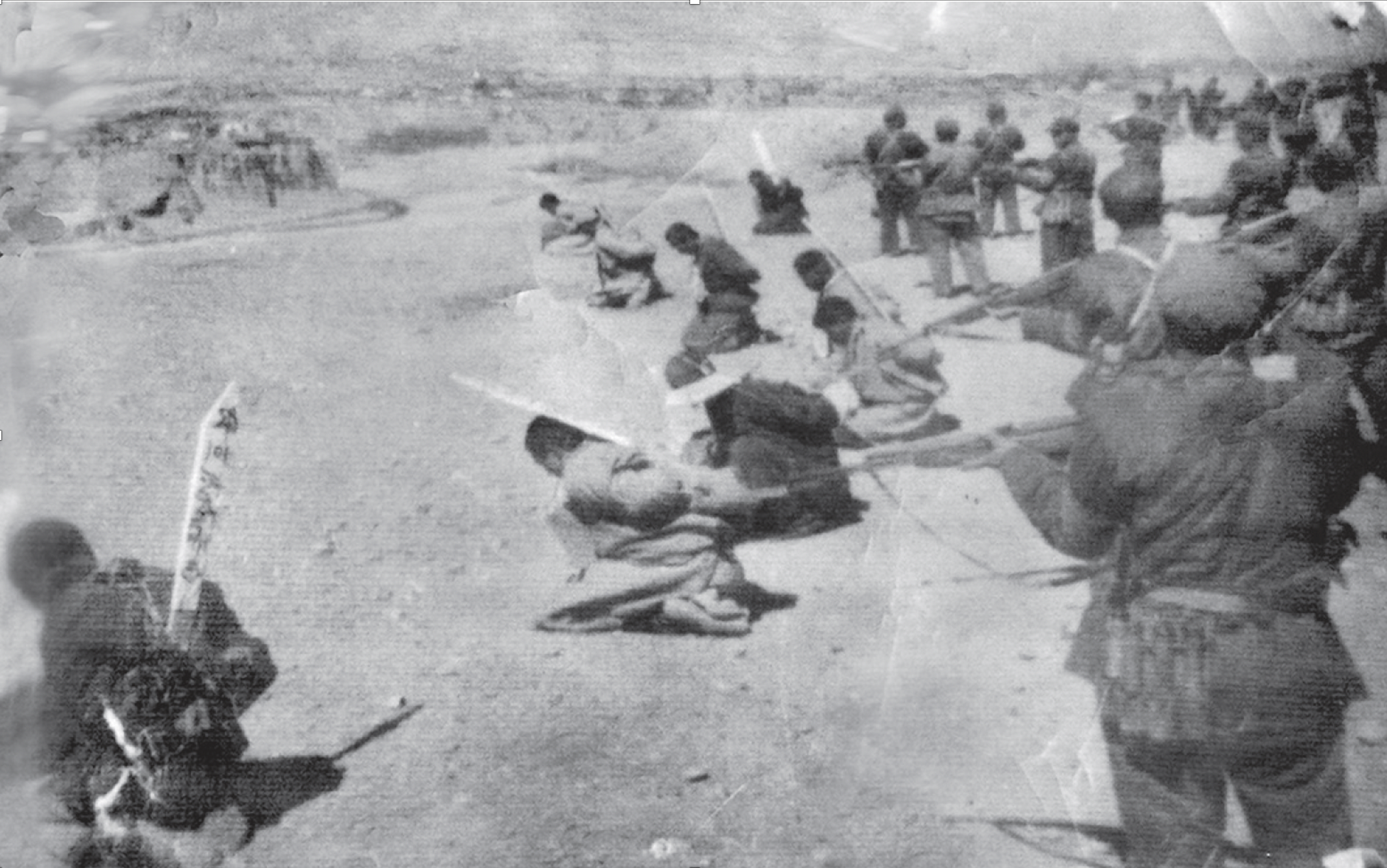
MASS GRAVES
In May 2012, a mass grave at Nangchen country in Yushu Tibetan Autonomous Prefecture, was discovered when excavation work for a building project started. Elsewhere in Yushu, in the grasslands near Pal-thang, another construction project uncovered more of the same: three mass burial pits filled with human remains. But not everything had decomposed. There were remnants of the clothes that the victims were wearing when they were thrown in: both lay clothing and monastic robes. The long hair of some of the dead was also still there.
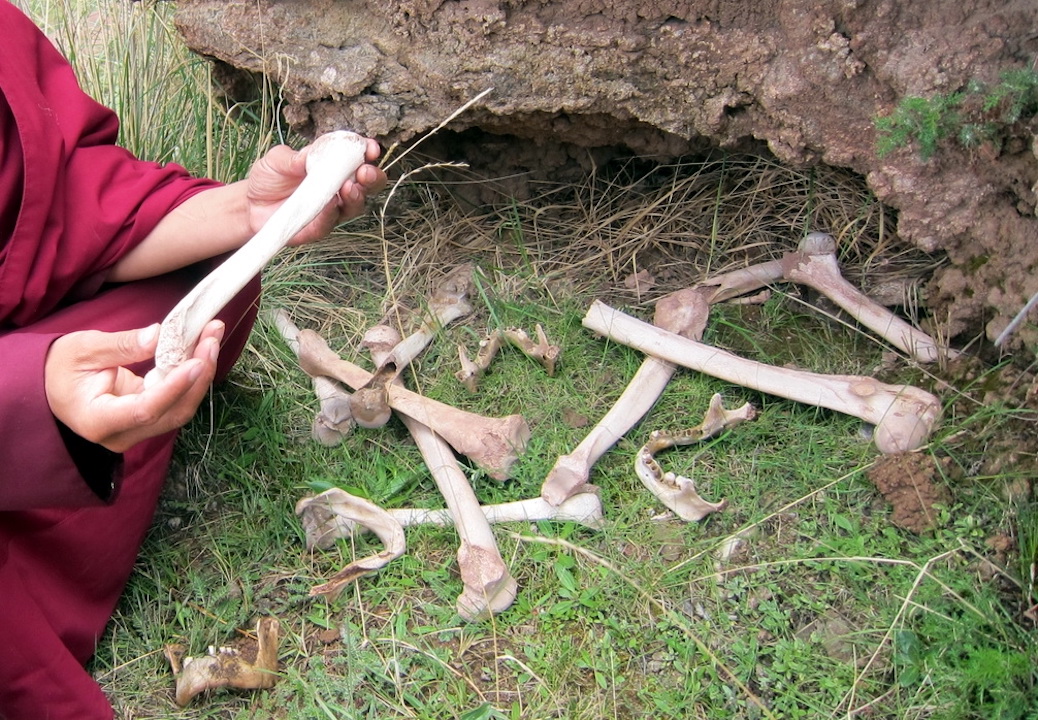
Mass Grave at Nangchen county, Yushu, 2012 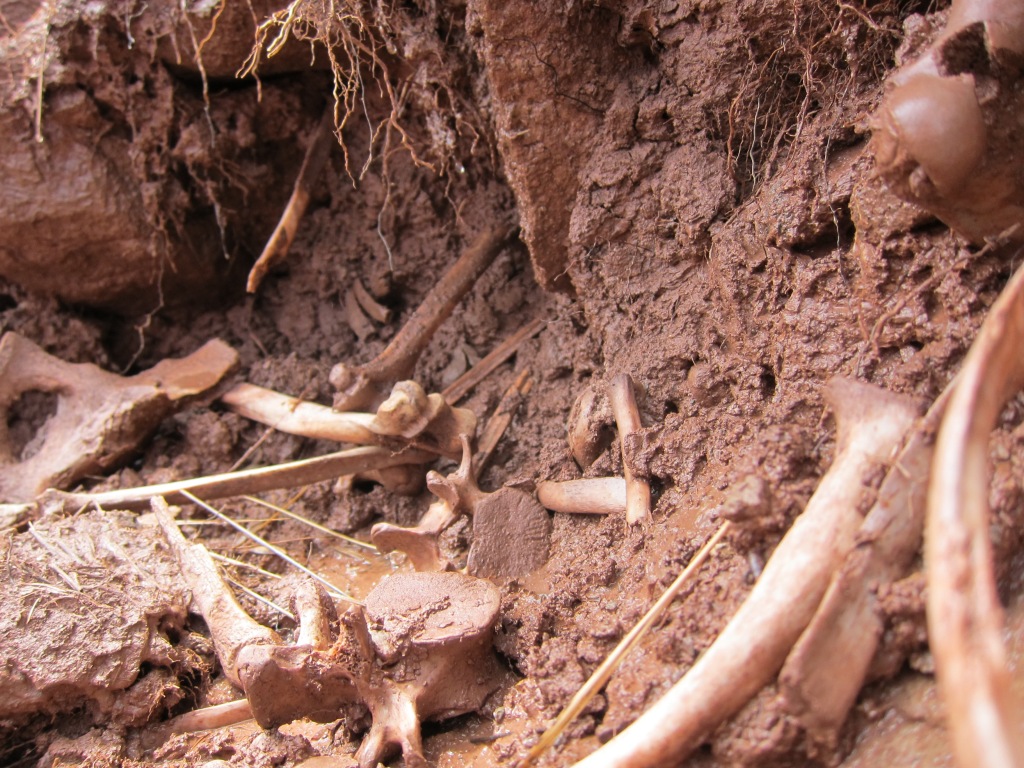
Mass grave at Nangchen county, Yushu, 2012
“According to elders these pits were from the 1958 massacres. Several trucks were needed to take the remains away.”[16] Mass graves are still being discovered elsewhere in the Tibetan Plateau in recent years as construction, roadbuilding, and mining has increased with China’s push for “development”.
PRC CENSUS REVEALS MASS DEATHS IN TIBET
Though official data on the killings in Tibet may be unavailable it is possible to gain an understanding of the scale of this conflict through the collated and analyzed results of China’s first reliable census data, derived from China’s 1982 census. The Tibetan Plateau in 1982 shows a widespread imbalance between males and females, an imbalance that can really only be explained by violent struggles and mass killings.
In the published cartographic data[17] the entire PRC is rendered largely blue while the Tibetan Plateau stands out in red as the largest expanse of territory in which the number of women consistently outstripped that of men. Yushu is in the red.
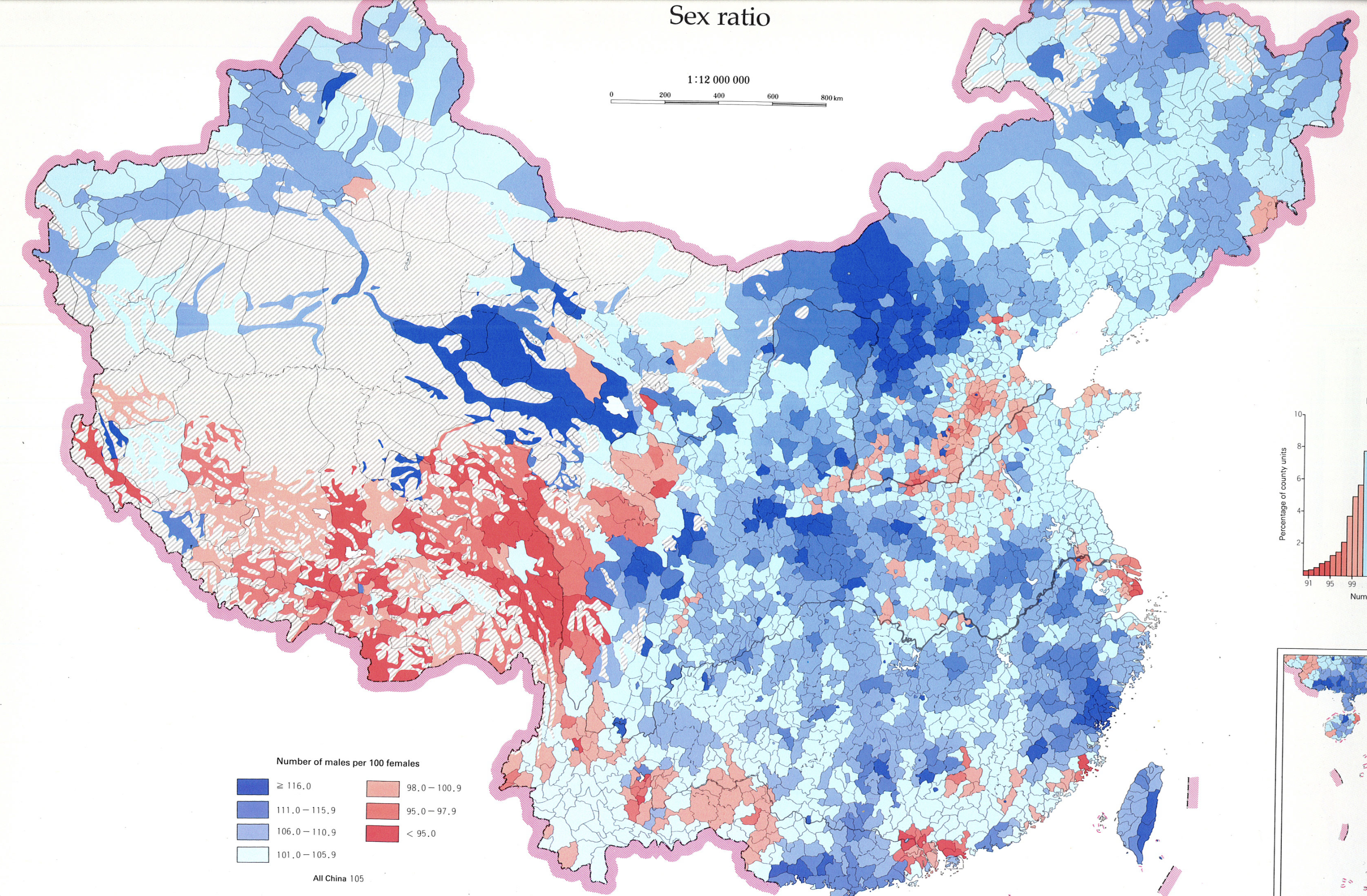
POLITICAL REEDUCATION CAMPS IN TIBET
A principal feature of China’s genocide campaign in Xinjiang has been the locking up and “brainwashing” of its ethnic Muslim minority people in numerous “Political Reeducation” camps.
In Tibet such “Political Reeducation” camps have been set up usually within monastery compounds, as many arrested protesters and activists were monks and nuns. In the 80’s such camps were set up in Drepung, Ganden and other monasteries around Lhasa. After the 2008 uprisings reeducation camps were established in various monasteries in Eastern Tibet, notably Kirti monastery in Amdo.
In 2017 a Tibetan monk inmate of a camp at Sog County “reform through re-education center” in Nagchu Prefecture of TAR, managed to smuggle his prison journal out of Tibet, which was obtained by Voice of America. He provides a lengthy account of brutal hardships and torture in the camp.[18] An independent Indian researcher has reported that internment camps like those built in East Turkestan for the Uyghur population are now spreading into Tibet. “New satellites images show the recent construction of several prison-like camps in Chinese occupied Tibet.”[19]
FORCIBLE NOMAD RELOCATION 2006 —
Many hundreds of thousands of previously self-sustaining Tibetan pastoral and nomad families have and are being forcibly relocated to “urban settlements” that bear a troubling resemblance to old Stalinist labor camps. The architectural scheme is a standard one: row upon row of uniform cinder-block huts often surrounded by high walls, without a temple, a school or even a store. A little distance from the outside walls police cars maintain constant surveillance, as an award winning 2008 British television documentary[20] revealed in chilling detail. Unable to speak or read Chinese the Tibetan inmates of these settlements, particularly the men, are slowly sinking into unemployment, depression, and alcoholism.
The relocation programs which started in the grasslands of Kham and Amdo has now (in 2021) extended to the nomads of theborder regions of Central and Western Tibet for “security reasons.”[21] The latest count is over 1.4 million nomads relocated.
TIBETAN LANGUAGE SUPPRESSION 1966 —
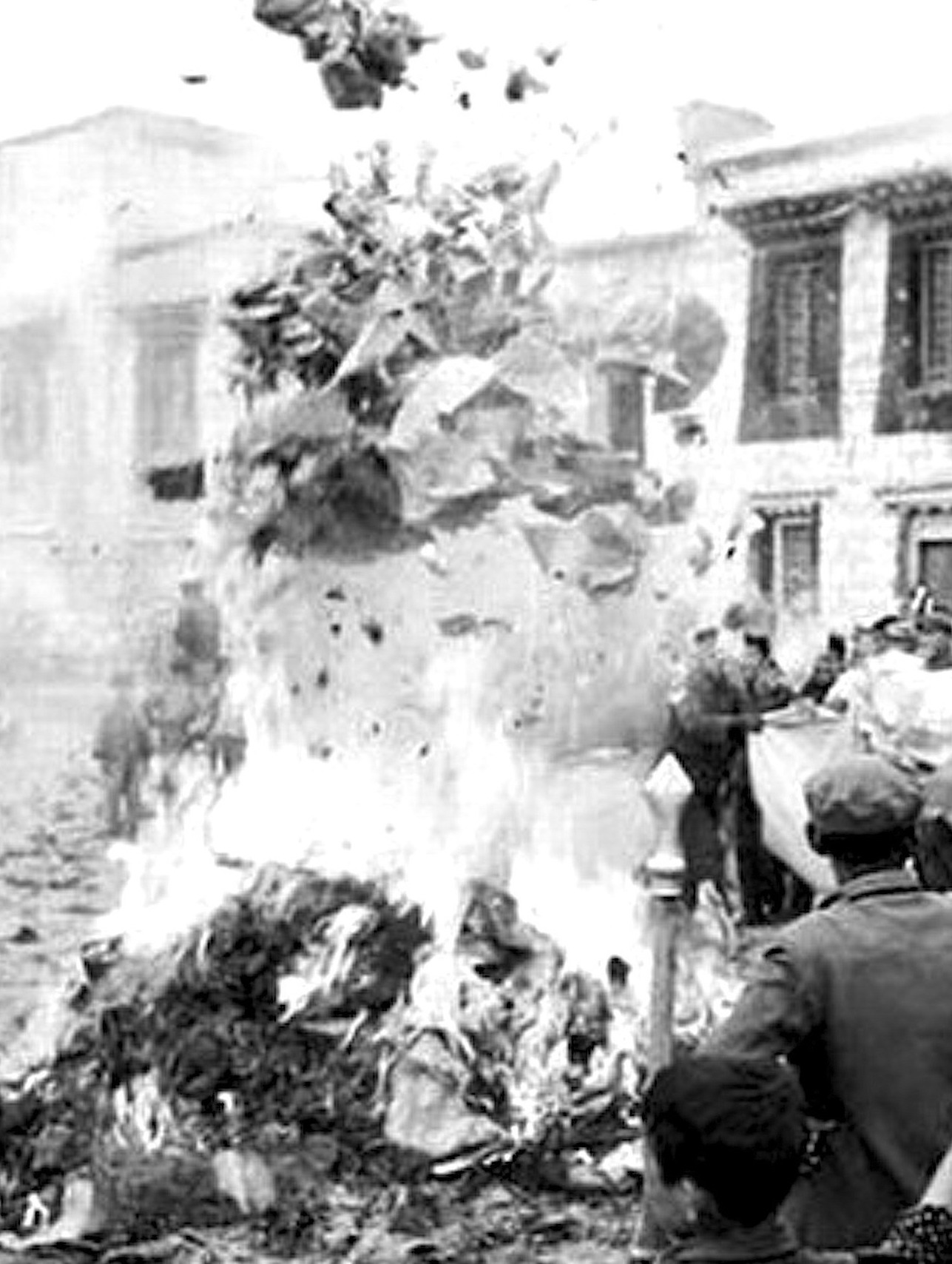
During the Cultural Revolution the Chinese occupation authorities in Tibet, made an extraordinary attempt not only to replace the written Tibetan language with Chinese, but to also forcibly discourage the use of the spoken language throughout the Tibetan plateau.[22] This was in addition to the destruction of many thousands of monastic libraries, large-scale burning of rare and precious traditional literature – when these were not used as toilet paper by Chinese soldiers and officials.[23]
In subsequent decades official campaigns to replace Tibetan with Chinese at schools, colleges, media, government offices and even in law courts in Tibet, have had considerable success. China is resolving this accomplishment with their latest boarding school campaign.
CHINA’S COLONIAL BOARDING SCHOOLS FOR TIBETAN CHILDREN
Chinese authorities in Tibet have set up a region-wide network of Chinese language boarding schools for Tibetan children, separating them from their parents and homes to reduce their contact with their native language and culture. For over 800,000 Tibetan children aged 6 to 18,(78% of school going children) attendance is mandatory. Classes in the schools are taught primarily in Chinese and feature intense political indoctrination according to a detailed and authoritative report by Tibet Action Institute.[24] Time Magazine citing the U.N, claims that “China’s Residential Schools Separate aMillion Tibetan Children From Their Families.”[25]
Starting in the 1880’s children from indigenous communities across Canada were taken from their parents by the government and sent to “boarding schools” funded by the state and run by the Catholic church.These schools were designed to assimilate and Christianize indigenous children. In July 2021 Pope Francis apologized for the boarding school program run by the Catholic Church in Canada for indigenous children. The pontiff specifically stated that genocide had taken place at these schools.[26] In the US there were more than 350 government-funded, and often church-run, Indian Boarding schools in the 19th and 20th centuries.[27]
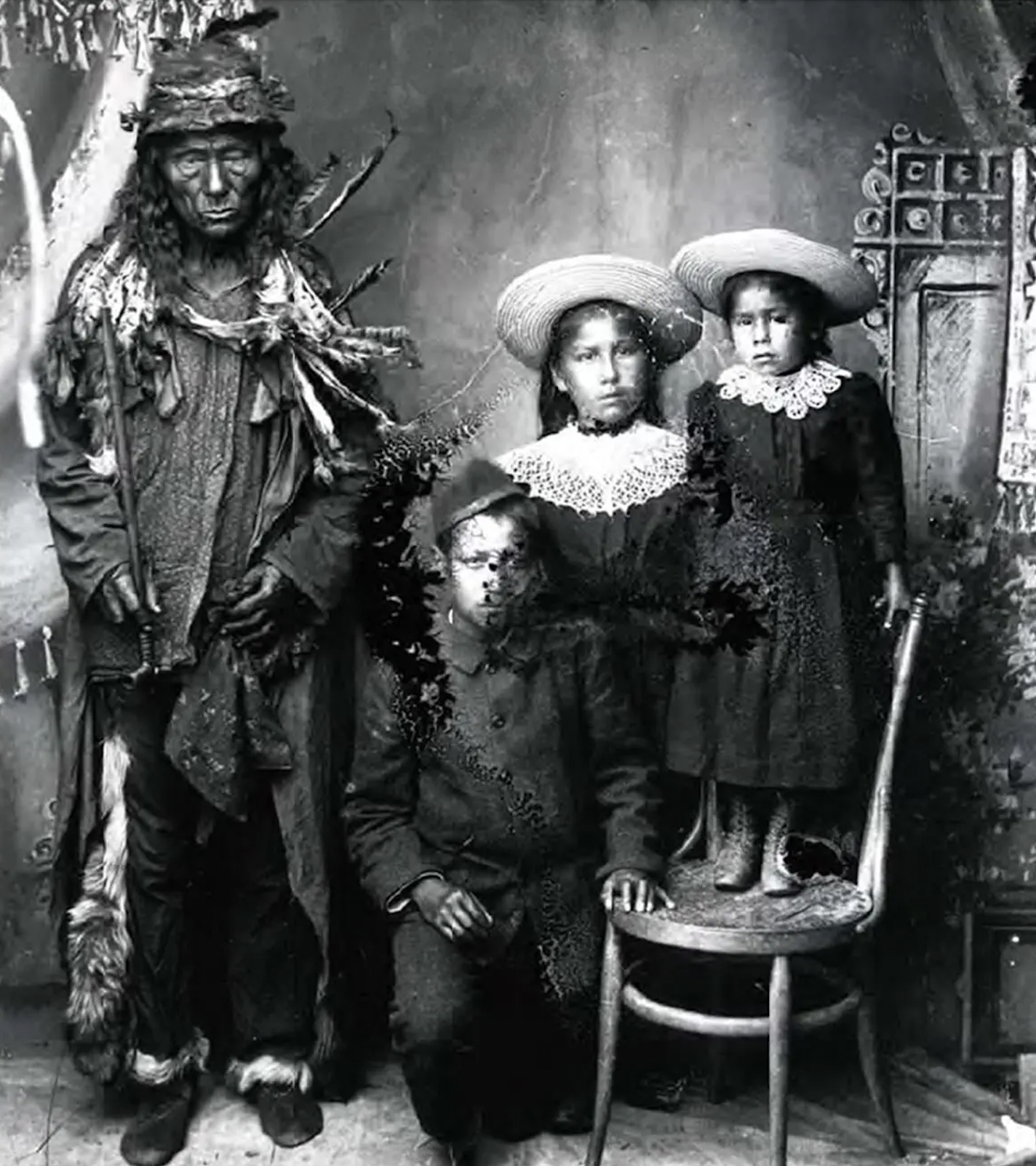
Posed photo of europeanized native Canadian children with native elder. 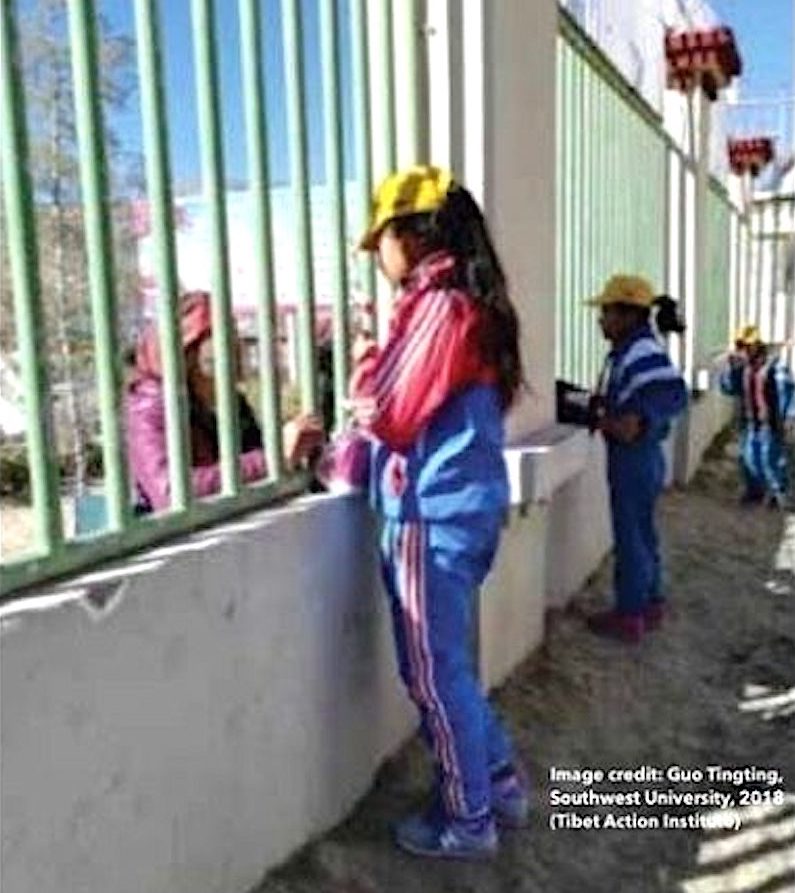
Tibetan children talking to their parents across a metal fence
DEFINITION OF GENOCIDE
Raphael Lemkin the Polish lawyer who coined the term “genocide” and initiated the Genocide Convention in the UN, said: “Genocide does not necessarily mean the immediate violent destruction of a nation. It is intended rather to signify a coordinated plan of different actions aiming at the destruction of essential foundations of the life of national groups, with the eventual aim of annihilating the groups themselves.”
UPDATE- BAN ON TIBETAN LANGUAGE EDUCATION IN KARDZE
In connection with China’s drive to undermine Tibetan language education in Tibet has been a report from London based research group Tibet Watch Oct 10. [28] that all the 20 or so counties in the historically Tibetan prefecture of Kardze (Chinese: Ganzi) of Sichuan Province will remove Tibetan language from their school curricula from next year. The ban was reported to have been notified in a circular issued by the prefecture’s Education Bureau in September. The ban applies to holding of Tibetan language classes from primary to high secondary schools, said the group, which is associated with the London-based Tibet campaign group Free Tibet (freetibet.org).
[1] International Commission of Jurists. The Question of Tibet and the Rule of Law. Geneva: 1959, p. 206.
[2] Jasper Becker, Hungry Ghosts: Mao’s Secret Famine, The Free Press, 1996, p166.
[3] Ibid. p.166.
[4] Frank Dekotter, Mao’s Great Famine, Bloomsbury, 2010.
[5] Ibid. p. 114.
[6] https://www.subliminal.org/tibet/testimony/1962-panchen.html
[7] Jasper Becker, Hungry Ghosts: Mao’s Secret Famine, The Free Press, 1996. p.177
[8] Jamyang Norbu, Echoes from Forgotten Mountains, Penguin Random House, Delhi, 2023, p.409.
[9] Adhe Tapontsang (as told to Joy Blakeslee) The Voice that Remembers: A Tibetan Woman’s Inspiring Story of Survival, Wisdom Publications, Boston, 1999.
[10] Tenpa Soepa. 20 Years of My Life in China’s Death Camp. Bloomington,IN: Author House, 2008
[11] Michael Wines (May 7, 2012). “China Expels Al Jazeera Channel”. The New York Times.
[12] Elliot Sperling, “The Body Count” https://info-buddhism.com/Body_Count-Mass_Death_in_Tibet-Elliot_Sperling.html
[13] Jamyang Norbu, Warriors of Tibet, Wisdom, Boston, 1986
[14] Elliot Sperling, Ibid.
[15] “The Panchen Lama Speaks”, DIIR, Dharamshala, India 1991
[16] Sperling Ibid.
[17] The Population Atlas of China. Oxford University Press, 1987.
[18] https://www.voanews.com/a/tibetan-re-education-camp-journal-tells-of-china-s-tactics-now-used-on-uighurs/4932153.html
[19] https://theprint.in/defence/china-claims-it-has-no-gulags-but-satellite-imagery-shows-3-new-ones-coming-up-in-tibet/190940/
[20] Jezza Neuman & Tashi Despa,, Undercover in Tibet , Channel 4, 2008.
[21] “Forced relocations and militarization of border regions continue in Central Tibet” https://www.tibetwatch.org/news/2021/4/30/forced-relocations-military-buildup-tibet
[22] Pema Bhum, Six Stars with a Crooked Neck: Tibetan Memoirs of the Cultural Revolution,
[23] Anthony P.King, “Tibet Endangered Civilization”, Agenda, March 1998.
[24] “Separated From Their Families, Hidden From the World” Tibet Action Institute. 2021
[25] https://time.com/6253481/china-tibet-million-children-separated-residential-schools/
[26] https://www.nytimes.com/2022/07/30/world/americas/pope-francis-canada-genocide.html
[27] https://boardingschoolhealing.org › Education
[28] TIBETWATCH: https://www.tibetwatch.org/news/2023/10/10/tibetan-language-classes-banned-in-kardze

